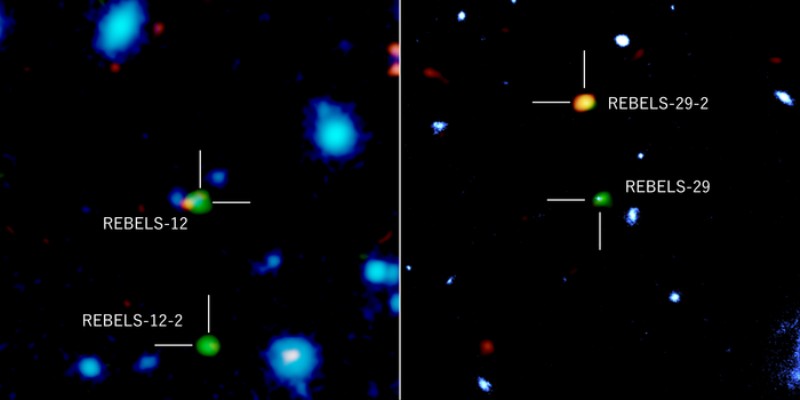A team of researchers has accidentally found two galaxies that were hidden from view sitting at the edge of space and time.
Yoshinobu Fudamoto, an astronomer at the Research Institute for Science and Engineering at Waseda University, Japan, and the National Astronomical Observatory of Japan (NAOJ), led the team that used the Atacama Large Millimeter/submillimeter Array (ALMA) located in Chile to make the discovery. ALMA is an astronomical interferometer made up of 66 radio telescopes that can see through dusty environments and over incredibly long distances.
The team found the two new galaxies while observing two target galaxies known as REBELS-12 and REBELS-29. The team discovered bright emissions thousands of light-years away from the target galaxies. This discovery prompted the team to conduct additional observations, which resulted in the discovery of two galaxies known as REBELS-12-2 and REBELS-29-2. These galaxies were hidden behind a cloud of cosmic dust and aren’t visible in UV and optical light.
The team noted that the “serendipitous discovery of these two dusty galaxies” at the edge of the universe “shows that our current (UV-based) census of very early galaxies is still incomplete,” according to a study published on Wednesday last week in Nature.
The lucky discovery suggests that as many as one in five galaxies at cosmic dawn may be hidden behind clouds of cosmic dust, which has implications for models of star and galaxy formation during this bygone epoch. Fudamoto and his colleagues suggest that “a blind, wide-area survey for such sources is required in the future,” in the study.

“These surveys must observe substantially deeper than had been envisioned previously to sample the fainter dust-obscured, but otherwise ‘normal’ galaxies such as REBELS-12-2 and REBELS-29-2,” the team concluded.
Researchers estimate that the newly discovered galaxies formed only 800 million years after the birth of the Universe that occurred 13.8 billion years ago.
READ MORE: There Was a Giant Galaxy Near to the Milky Way Eaten by Andromeda






Prove it….. or write a paper about it…. ‘The Density of Interstellar Medium From Earth to the ‘Edge of the Universe’ every Degree of R.A. & Declination & Quantity of galaxies that could be hidden in it’. Would make a fine Doctoral Thesis.
Awesome article, great job!